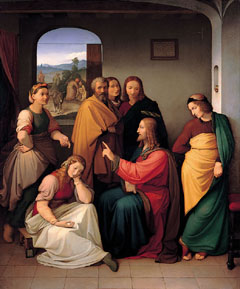"the report calls for the elimination of [policies] that prohibit women from being directly assigned to combat units"
Body
Discussion
Women in the Life and Ministry of Jesus
 The popularity of The Da Vinci Code has forced Christians to realize that their beliefs are open to challenge. As a result, many Christians are interested in subjects that used to draw yawns. A few years ago, no one wanted to hear about the Gnostic Gospels and why we reject them, for example.
The popularity of The Da Vinci Code has forced Christians to realize that their beliefs are open to challenge. As a result, many Christians are interested in subjects that used to draw yawns. A few years ago, no one wanted to hear about the Gnostic Gospels and why we reject them, for example.
One issue raised by The Da Vinci Code is Jesus’ relationship to women. We can easily surmise that the Mary Magdalene nonsense of The Da Vinci Code is bogus, but what was Jesus’ real attitude toward women?
On the one hand, He established the church by training her basic leaders, the apostles. Only men were chosen as apostles, and the concept of male leadership in the church is consistent throughout Scripture: the Old Testament priests had to be male (according to Moses) and Paul teaches that church leaders who teach doctrine or Bible to men must be male, as must elders (1 Tim. 2:9-15, 3:1-2).
On the other hand, God used prophetesses as a channel of divine communication (e.g., Miriam, Deborah, in the Old Testament and the daughters of Philip in the New), and both men and women were encouraged to prophesy in the early church (1 Cor. 11:3-11).
Most of us understand that the reasons for these restrictions on leadership have nothing to do with competence or ability. Most of us know strong, capable godly women who have mastered the Word, as well as not-so-godly Christian men who have not. Nor are these restrictions justified on the basis of ancient culture (and thus no longer relevant). Instead, they are anchored to the order of creation and the events of mankind’s fall into sin (see 1 Tim. 2:9-15), past events that do not change (as does culture). The leadership of men in the home or in the church rises or falls together since they are mandated with similar justification. However, it takes quite a stretch to translate this concept into the political or work world.
Discussion
"They are ignoring us"
Body
Discussion
"The Council on Biblical Manhood and Womanhood has placed a greater priority on women's submissive role rather than on the gospel of Jesus Christ"
Body
Discussion
Mothers Saved in Childbearing? Part 2
 Reprinted (with permission) from Faith Pulpit, March/April, 2010. See Part 1.
Reprinted (with permission) from Faith Pulpit, March/April, 2010. See Part 1.
The Meaning of “She Will Be Saved in Childbearing”
In view of these considerations, what does the phrase “she will be saved in childbearing” mean? Several views have been offered:
Discussion
Mothers Saved in Childbearing? Part 1
 Reprinted (with permission) from Faith Pulpit, March/April, 2010.
Reprinted (with permission) from Faith Pulpit, March/April, 2010.
The topic of a woman’s role in the church has been one of the most heated debates in contemporary Christianity. Moreover, a woman’s role in the home, as a wife and mother, is under attack in our culture. In this article, Mrs. Martha Hartog, adjunct faculty member at Faith Baptist Bible College in Ankeny, Iowa, addresses this issue with a thoughtful examination of the phrase, “she will be saved in childbearing” (1 Tim. 2:15).
In I Timothy 2:8-15 Paul focused on a woman’s role in the church as well as her role as a mother. The passage closes with these words: “Nevertheless she will be saved in childbearing if they continue in faith, love, and holiness, with self-control” (2:15).1 A brief look at its context and some grammatical matters should help us understand the meaning and importance of this verse.
Discussion
Book Review - And She Lived Happily Ever After: Finding Fulfillment as a Single Woman
[amazon 0830832653 thumbnail] |
Why is a married woman reviewing a book about fulfillment as a single woman? I think I might have a vested interest in such subject matter. I was nearing my 31st birthday on the day my husband and I exchanged vows. I spent years wading through misconceptions and stereotypes, confusion and disappointment. I wish there had been a valuable tool like this book available during those years.
Skip McDonald is now fifty-five years old, satisfied and single. She says of herself, “If one day [God] decides he wants me to marry, I’m confident he’ll make that clear. But I have to admit that I often thank him for my singleness and remind him that I would like to die a single woman” (p. 113).
That’s some out-of-the-box thinking for most single women. This book is a description of her journey to such contentment, a journal of frank observations, and a guide in which Skip bequeaths to her readers the hope she has found in God’s perfect design.
Strengths
The book is a very accessible 150 pages of easy reading. That is not to say it is not full of deeper thinking, but that it is top-shelf truth placed on an accessible bottom shelf. She provides illustration of her points by way of “interviews” with various single ladies on aspects of the single life. It feels much like a group discussion, with the additional input effectively fleshing out selected points. I would not have hesitated to place this book in the hands of any of the many students I counseled, who were afflicted with “freshman frenzy,” the rash that develops later into “senior panic.”
Discussion
Book Review - Becoming God's True Woman
[amazon 1433503662 thumbnail] |

Discussion